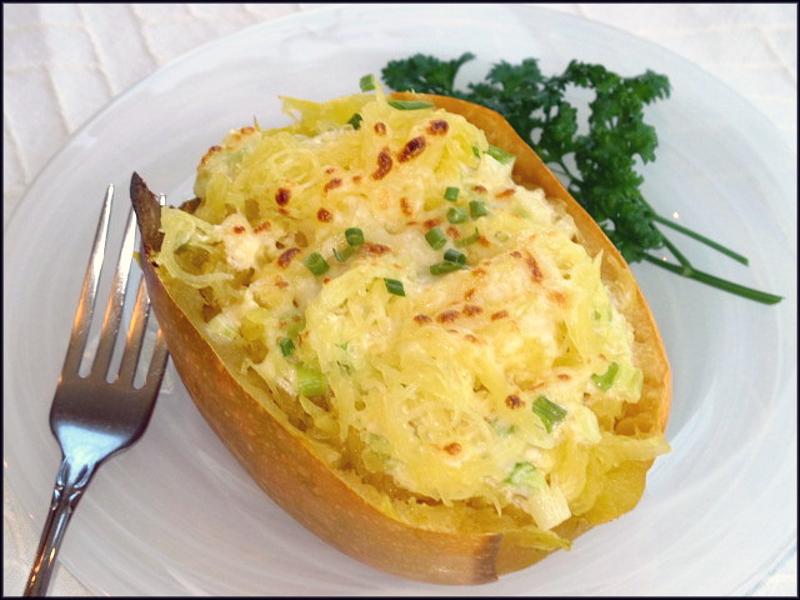Spaghetti squash adds fall flavor to varied menus
On a recent trip to Lewes, our friend Pat Driscoll arrived with a seed-starter tray full of squash seedlings. Of course, since this was Pat, these weren’t just ordinary winter squash, but a collection of heirloom varietals like Delicate, Kabocha, Long Island Cheese and Blue Hubbard. We spent an hour tucking the seedlings into the soil, hoping the deer wouldn’t find them too interesting.
The seedlings have now spent over two months in the ground, through a hot and rainy summer season. Of the two dozen originally planted, only about one-third of them have survived. Bright-orange blossoms have faded and there are the beginnings of baby squash forming on the vines. However, since these are winter squash, they won’t be ready to pick for several more weeks.
While I’m waiting for those in the garden to ripen, I was able to find another delicious winter squash at the market – the golden-colored spaghetti squash. First, by way of definition, summer squash have tender, edible skins and delicate flesh that cooks quickly, while winter squash have tough, inedible rinds and require longer cooking times. Summer squash are more perishable than winter squash, which can be stored from several weeks up to months.
What makes spaghetti squash a little different from others like butternut or acorn is the way its flesh comes away from the rind. If you scrape out the cooked flesh from most squash, including pumpkin, it will readily mash into a paste. Spaghetti squash, instead, forms long strands of flesh when scraped with a fork. When cooked properly, thes e strands have both the texture and appearance of spaghetti.
One of the more expected ways to serve spaghetti squash is as a replacement for high-carbohydrate pasta in a tomato sauce. I find this isn’t the best place for the delicate squash and prefer recipes where it is the prominent ingredient and treated with subtle flavor additions, as in the dish pictured. Because of the color, it might be difficult to see the separate strands, but they are in every mouthful.
The sauce was simmered stovetop while the squash baked in the oven. The two components were stirred together and toasted under the broiler. The combination could be served in a large casserole dish, individual dishes or as it is here, mounded back into the empty rinds.
This recipe calls for minced shallots, but green onions work just as well. Just a splash of half-and-half was all it took to deglaze the skillet and cook down the mixture into a slightly thickened, creamy sauce for the squash. I sprinkled the top with grated cheese, which is seen as browned spots. I added a dusting of of snipped chives, but any bright-green herb such as parsley will add a touch of color.
One thing I learned about spaghetti squash is that you can cook it too much and create a watery mess if you don’t cut it in half and remove the seeds first. Also, if you see the rind starting to brown, that’s a sign it might have been baked a little too long. Spaghetti squash cooks much faster than the denser winter squash, and you want to make it as “al dente” as you like your pasta.
I’ve included the recipe I used for the photo as well as one for cacio e pepe (cheese and pepper) with spaghetti squash. I’ll keep you posted on how the rest of Pat’s seedlings become full-grown squash.
Twice Baked Spaghetti Squash
1 large spaghetti squash
1 t olive oil
1 T butter
2 minced shallots
1/2 C half & half
1/3 C shredded mozzarella cheese
snipped chives, for garnish
Preheat the oven to 375 F. Slice the spaghetti squash in half lengthwise; scoop out the seeds and ribbing. Drizzle the inside of the squash with olive oil. Place the spaghetti squash cut side down on a baking sheet. Use a fork to poke holes in the rind. Bake for 30 to 40 minutes; it should be fork tender, but still firm. Remove from the oven and allow to cool slightly. While squash is cooling, melt butter in a large skillet. Add shallots and sauté until softened. Add half and half; cook until reduced and thickened. Using a fork, scrape the long strands of flesh from the squash, reserving the empty rinds. Add squash to the skillet, tossing gently to combine. Mound squash in the rinds and sprinkle with mozzarella. Place under the broiler for about 5 minutes to lightly brown the cheese. Garnish with chives. Yield: 4 servings.
Cacio e Pepe Squash
1 large spaghetti squash
1 t olive oil
2 T butter
1/2 C vegetable stock
1/2 C Pecorino Romano cheese
1 t cracked black pepper
salt, to taste
parsley, for garnish
Preheat the oven to 375 F. Slice the spaghetti squash in half lengthwise; scoop out the seeds and ribbing. Drizzle the inside of the squash with olive oil. Place the spaghetti squash cut side down on a baking sheet. Use a fork to poke holes in the rind. Bake for 30 to 40 minutes; it should be fork tender, but still firm. Remove from the oven and allow to cool slightly. While squash cools, melt butter in a skillet over low heat. Stir in stock and bring to a simmer. Using a fork, scrape the long strands of flesh from the squash. Add squash to the skillet along with cheese and pepper. Toss gently to combine. Season to taste with salt and serve garnished with chopped parsley.






















































